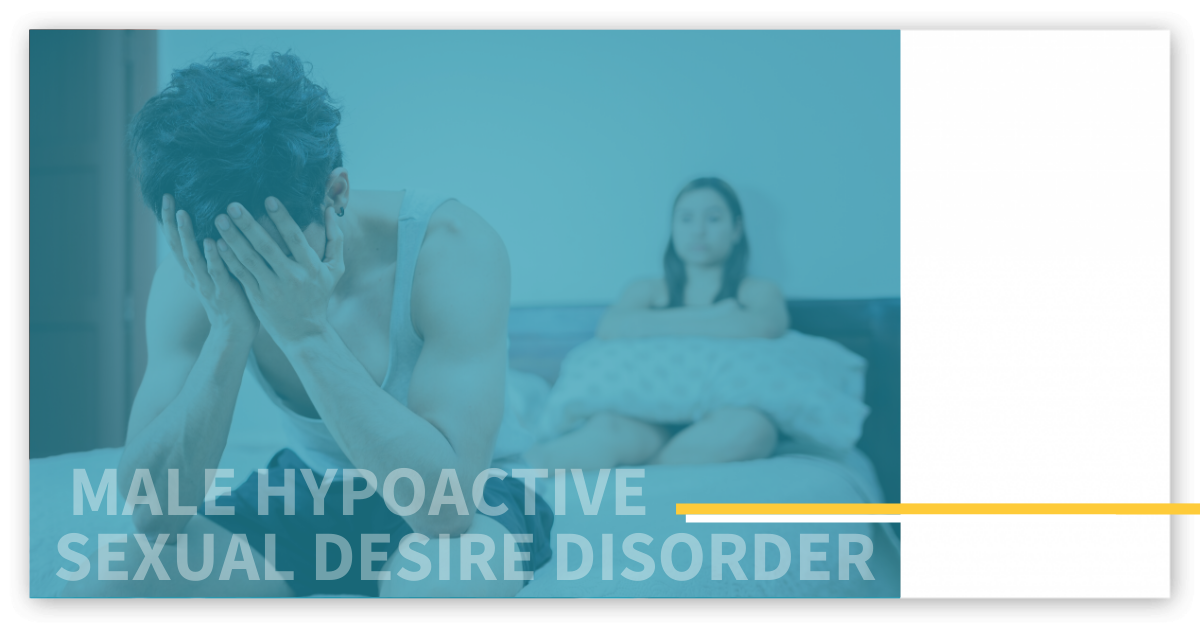Male Hypoactive Sexual Desire Disorder (Low Sex Drive)

Men with Hypoactive Sexual Desire Disorder experience a consistent or occasional lack of interest in sexual activity and a low sex drive. This low sex drive can significantly impact a man’s quality of life and can strain intimate relationships. Normal sex drive can fluctuate for many people depending on life stressors, relationship issues, and other medical conditions. However, Male Hypoactive Sexual Desire Disorder goes beyond occasional periods of low libido. Instead, it involves a persistent and problematic disinterest in sexual activities that lasts for at least 6 months and causes sufferers significant distress.
Causes and Risk Factors
Rates
Low sex drive is not uncommon in men of all ages. Over 5% of young adult men have trouble with low sex drive and over 40% of men over 65 have this issue as well.
Medical issues and medication side effects
Antidepressants, such as paroxetine (Paxil), fluvoxamine (Luvox), sertraline (Zoloft), and fluoxetine (Prozac) all have the potential to significantly impair peoples’ sex drives. Radically decreased sex drive is also a common result of anxiety, depression, and overall life stress. Trauma, including sexual trauma and trauma that has lead to PTSD can also impair sexual desire.
Several other, non-psychiatric conditions can also contribute to Male Hypoactive Sexual Desire Disorder. These include diabetes, high cholesterol, obesity, thyroid conditions, and heart disease.
Attitudes towards sex
People who are raised in environments that promote shameful attitudes towards sex can often suffer from decreased sexual desire. This is most likely to happen in men whose sexuality is shamed by certain cultures or religions. Additionally, men suffering from Male Hypoactive Sexual Desire Disorder are often less likely to search out help for it because of societal attitudes that expect men to be desirous of sex.
Relationship factors
Desire for sex can also be affected by the quality of a man’s relationship with his partner. Poor communication about wants and needs regarding intimacy, arousal, and sex can all pile on together to make relationships more strained. This can lead to low sex drives in one or both partners. It’s definitely an avenue to explore when someone might have Male Hypoactive Sexual Desire Disorder.
Co-occurring disorders
Male Hypoactive Sexual Desire Disorder often happens alongside other sexual dysfunctions, such as erectile dysfunction or delayed ejaculation.
Diagnosing Male Hypoactive Sexual Desire Disorder
Men with Male Hypoactive Sexual Desire Disorder (low sex drive) consistently suffer from a reduced desire for sex. They also have fewer sexual thoughts and fantasies. There is no hard line for what constitutes “reduced” desire, though. That’s an answer for the individual and their doctor to answer. They stop initiating sex with their partners and don’t respond to their partners’ advances. Instead, the doctor making the diagnosis makes that assessment using all the available information about the situation, including the person’s age and social circumstances. These issues last at least 6 months and cause significant distress. It can either have lasted throughout a person’s entire sexual maturity or appear after years of normal sexual desire and functioning.
Treating Male Hypoactive Sexual Desire Disorder
Changing medications
Treatment for Male Hypoactive Sexual Desire Disorder largely depends on what is causing the problem. Many times the key issue is either a medication or a medication condition that is leading to an abnormally low sex drive. If that might be the problem, check with the doctor prescribing those medications and
Psychotherapy
Psychotherapy helps treat Male Hypoactive Sexual Desire Disorder when psychiatric symptoms or relationship problems are involved. Therapy helps people address issues like stress, anxiety, depression, body image, or trauma that might be causing a low sex drive in men. Additionally, when relationship problems are an issue, couples therapy offers a supportive environment to address communication problems and emotional barriers. Cognitive Behavioral Therapy (CBT), a specific form of psychotherapy, can be particularly effective, helping individuals challenge negative sexual beliefs and anxieties.
Sex Therapy
In sex therapy, individuals or couples work with a specialized counselor to explore the psychological, emotional, and relational factors contributing to Male Hypoactive Sexual Desire Disorder (low sex drive). Education and behavioral techniques play a crucial role in sex therapy. Therapists teach effective communication skills, fostering open and non-judgmental discussions about sexual desires and needs. Additionally, intimacy-building exercises help individuals feel more comfortable and connected during sexual encounters.
Testosterone Replacement Therapy
One of the causes of an abnormally low sex drive in men is low testosterone. If the doctors don’t find an external medical cause of low testosterone, they can simply supplement with testosterone therapy. Testosterone Replacement Therapy (TRT) is a medical treatment that increases the levels of testosterone in people via pills, injections, creams, or patches. Increased testosterone levels from this treatment will increase sex drive in men for whom low testosterone was the main issue.
Managing Male Hypoactive Sexual Desire Disorder
Importance of communication
Open and honest communication with a partner can be a crucial step for managing Male Hypoactive Sexual Desire Disorder. A supportive and understanding partner can play a significant role in addressing relationship issues related to the condition. If you have trouble doing this, a couple’s therapist is a great place to start the conversation.
Asexuality
Asexuality is a sexual orientation characterized by a lack of sexual attraction or interest in engaging in sexual activities with others. Asexual individuals may experience little to no desire for sexual activity, but this lack of interest is not considered a disorder. Additionally, asexual people do not feel any distress from their lack of desire. That distress is a key ingredient of disordered low sex drive in men (Male Hypoactive Sexual Desire Disorder).


 Learn
Learn Find Help
Find Help